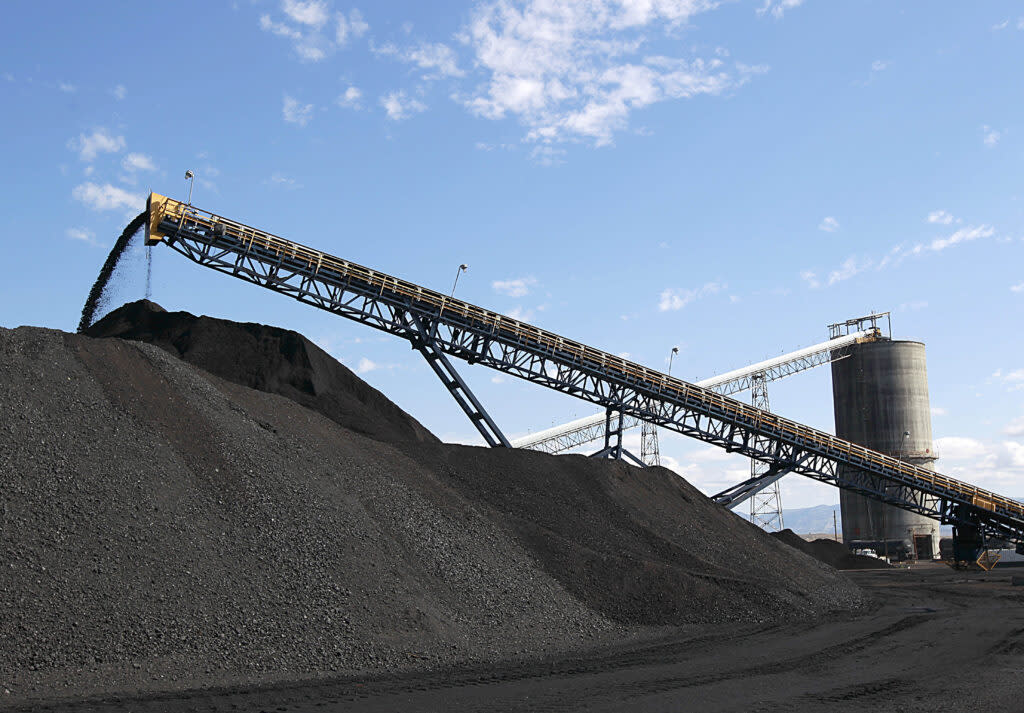In coal-obsessed Utah, a proposal to extend the life of an uneconomic and polluting coal plant

Coal falls off a conveyer belt as it's off loaded from trucks from local coal mines at the Savage Energy Terminal on Aug. 26, 2016 in Price, Utah. (Photo by George Frey/Getty Images)
The Utah Legislature’s love affair with coal was on full display this past legislative session, with a Hail-Mary attempt to keep the Intermountain Power Plant operating (SB 161) and multiple laws that create clear preferences for coal-generated power, regardless of cost (SB 224, HB 191), among others. Under the radar was Deseret Power’s filing before the Utah Public Service Commission asking to extend operations at its Bonanza coal plant into the 2040s. This move contradicts the urgent scientific consensus that the planet needs to stop burning coal by 2030 to avoid the worst impacts of climate change. But the powers-that-be in Utah seem to be living on a different planet.
Deseret’s 500 MW Bonanza coal burning power plant in Uintah County spews over 4 million tons of carbon dioxide into the atmosphere every year, along with thousands of tons of nitrogen oxides (NOx) and sulfur dioxide (SO2). NOx and SO2 are terrible for our health. Breathing in these pollutants can cause or worsen respiratory diseases, aggravate heart disease, increase asthma symptoms, and even lead to premature death. They also contribute to haze in our national parks, marring the scenic vistas that we all cherish from the Mighty Five right here in Utah to parks as far away as Grand Teton and Rocky Mountain.
It’s because of this pollution that a settlement agreement between Sierra Club, WildEarth Guardians, and Deseret Power imposes a limit on how much more coal Bonanza may burn, effectively requiring closure by 2030. Deseret had the option, though, to spend the hundreds of millions of dollars to reduce its NOx and SO2 pollution and keep the plant going. Specifically, if Deseret installs “selective catalytic reduction” (SCR) control technology by 2030, then it can also apply to extend the operating life of Bonanza.
This year, Deseret did just that: it asked the Public Service Commission for pre-approval to install SCR, even though these pollution controls will do nothing to reduce Bonanza’s CO2 emissions. What’s worse, it’s Deseret’s customers who will ultimately pay the costs of installing and operating the pollution controls, in addition to normal operations and maintenance costs.
SCR pollution controls are expensive, likely costing upwards of $200 million to install. That would likely drive up the cost of operating Bonanza from about $34/megawatt-hour (MWh) to closer to $39/MWh. Maybe that doesn’t seem like a lot, but it is. At $39/MWh, Bonanza would be more expensive than replacing the plant with clean energy as early as this year and no later than 2027, based on a model analysis conducted by Sierra Club that compared the costs of replacing coal plants’ energy and capacity output with clean resources. In fact, even without spending hundreds of millions of dollars on SCR pollution controls, the analysis shows that Bonanza is uneconomic compared to clean energy replacement resources as early as 2027.
So, did Deseret conduct an analysis evaluating whether continuing to operate Bonanza would be lower cost than replacing the plant’s output with wind, solar, storage, and geothermal? It doesn’t appear so. Did Deseret evaluate the likelihood of future environmental regulations that could limit or even prohibit coal burning at the plant past 2030? No, not that either. In fact, Deseret downplayed the potential for future regulation, even as the U.S. Environmental Protection Agency announced a slew of new regulations that will force coal plant operators to internalize the costs of their plants’ pollution. These include regulations addressing coal ash, waste water discharge, mercury and air toxics emissions, and CO2 emissions. None of the requirements under these rules will be met by SCR–they will all require greater investments in an already very expensive coal plant.
What’s striking is that the SCR installation isn’t needed right now. Deseret is free to operate Bonanza without SCR until 2030. So why not take the time to fully evaluate whether this multi-million dollar expenditure is the right option for customers? No, the company would rather push through this spending by 2026, riding the coattails of a coal-punch-drunk legislative session.
The post In coal-obsessed Utah, a proposal to extend the life of an uneconomic and polluting coal plant appeared first on Utah News Dispatch.

